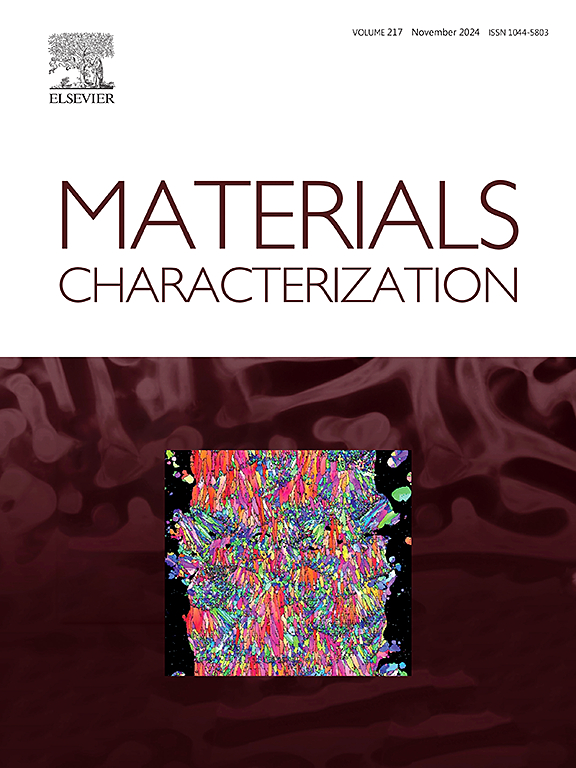添加ZrB2提高Mo-Si-B合金1100 ~ 1300℃高温强度的研究
IF 4.8
2区 材料科学
Q1 MATERIALS SCIENCE, CHARACTERIZATION & TESTING
引用次数: 0
摘要
本课题研究了ZrB2添加量对Mo-12Si-8.5B (at. 0)的显微组织和高温抗压强度(1100℃- 1300℃)的影响。%)合金。结果表明:Mo-12Si-8.5B合金的高温强度与ZrB2的加入及组织尺度密切相关,ZrB2使Mo-12Si-8.5B合金的晶粒尺寸变小,有利于提高1100℃时的强度,但在1300℃时却大大降低了强度,甚至抵消了添加ZrB2后产生的富锆颗粒的积极作用。可见,在相同晶粒尺寸的前提下,添加1.5 wt% ZrB2显著提高了Mo-12Si-8.5B合金在1100℃- 1300℃温度范围内的屈服强度和峰值应力。特别是在1200℃时,屈服强度提高了30%,而在1300℃时,屈服强度提高了15%。添加ZrB2后的Mo-Si-B合金具有优异的力学性能,这是晶内富锆颗粒弥散强化、晶间富锆颗粒钉住效应和晶界净化的协同作用所致。此外,这些富锆颗粒还阻碍了Mo-12Si-8.5B合金的动态再结晶行为,增强了合金的抗软化性能。本文章由计算机程序翻译,如有差异,请以英文原文为准。
Understanding improved high temperature strength of Mo-Si-B alloy at 1100–1300 °C based on ZrB2 addition
In this study the influence of ZrB2 addition on microstructure and high temperature compressive strength (1100 °C–1300 °C) of Mo-12Si-8.5B (at. %) alloy was investigated. Results showed that the high temperature strength was closely related to the ZrB2 addition as well as the scale of the microstructure, and the smaller grain size of Mo-12Si-8.5B alloy resulted from ZrB2 was beneficial to the improvement of the strength at 1100 °C but greatly deteriorated the strength at 1300 °C, which even counteracted the positive effect of Zr-rich particles derived from ZrB2 addition. Clearly, under the premise of the same grain size, the addition of 1.5 wt% ZrB2 significantly resulted in the improved yield strength and peak stress of the Mo-12Si-8.5B alloy within the temperature range of 1100 °C–1300 °C. Specially a remarkable increase of 30 % in yield strength was observed at 1200 °C, while at 1300 °C, the yield strength rose by 15 %. The excellent mechanical properties of the Mo-Si-B alloy with ZrB2 addition could be attributed to a synergistic effect of intragranular Zr-rich particles dispersion strengthening, intergranular Zr-rich particles pinning effect and grain boundary purification. Additionally, these Zr-rich particles also hindered the dynamic recrystallization behavior and enhanced the softening resistance of the Mo-12Si-8.5B alloy.
求助全文
通过发布文献求助,成功后即可免费获取论文全文。
去求助
来源期刊

Materials Characterization
工程技术-材料科学:表征与测试
CiteScore
7.60
自引率
8.50%
发文量
746
审稿时长
36 days
期刊介绍:
Materials Characterization features original articles and state-of-the-art reviews on theoretical and practical aspects of the structure and behaviour of materials.
The Journal focuses on all characterization techniques, including all forms of microscopy (light, electron, acoustic, etc.,) and analysis (especially microanalysis and surface analytical techniques). Developments in both this wide range of techniques and their application to the quantification of the microstructure of materials are essential facets of the Journal.
The Journal provides the Materials Scientist/Engineer with up-to-date information on many types of materials with an underlying theme of explaining the behavior of materials using novel approaches. Materials covered by the journal include:
Metals & Alloys
Ceramics
Nanomaterials
Biomedical materials
Optical materials
Composites
Natural Materials.
 求助内容:
求助内容: 应助结果提醒方式:
应助结果提醒方式:


